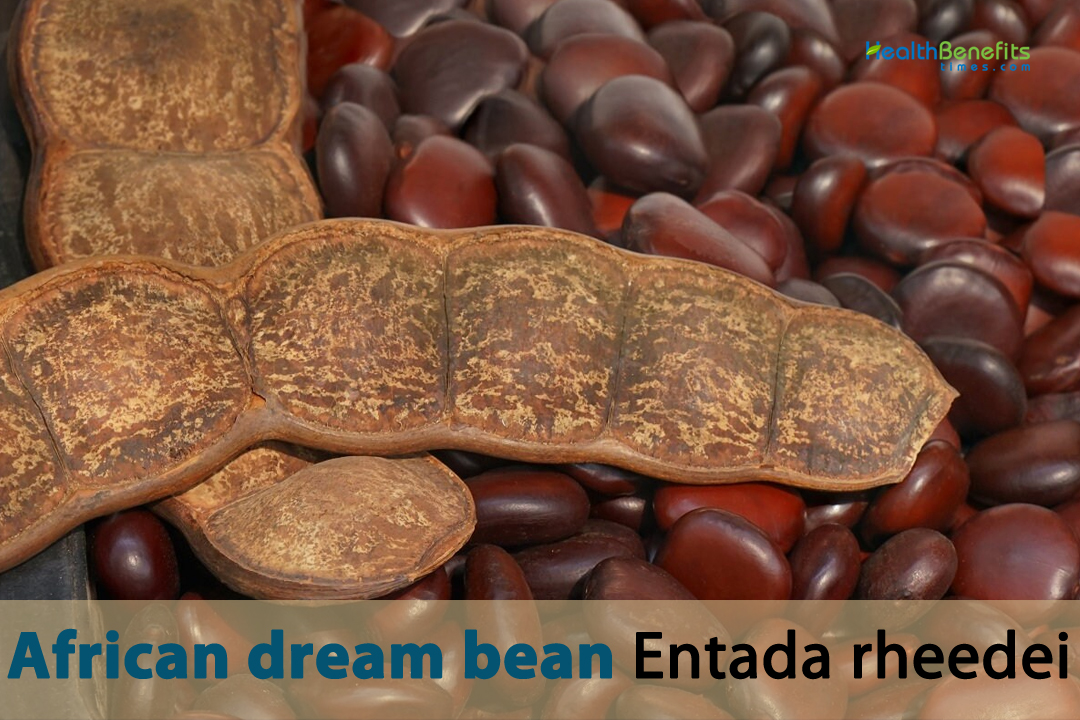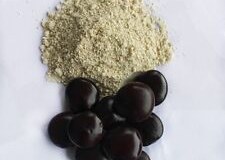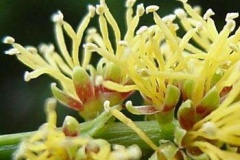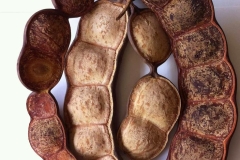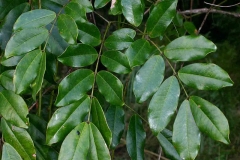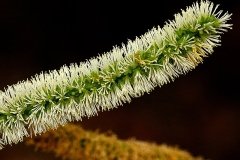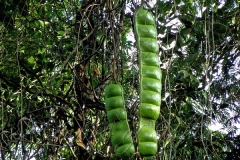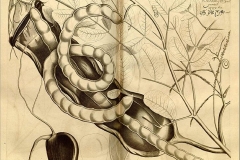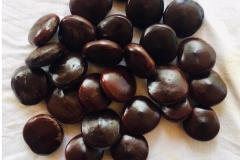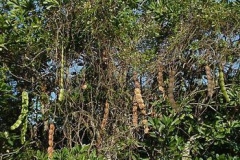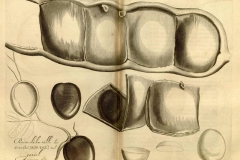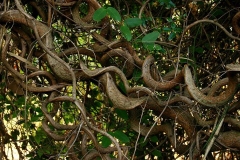| African dream bean Quick Facts | |
|---|---|
| Name: | African dream bean |
| Scientific Name: | Entada rheedei |
| Origin | Tropical and subtropical regions of Africa |
| Colors | Range from green to brown |
| Shapes | Enormous flat, woody and segmented pod, that measures up to 2 m long and 150 mm wide |
| Taste | Bitter, astringent taste |
| Health benefits | Pain Relief, Mental Clarity and Focus, Stress Reduction, Improved Sleep Patterns, Enhanced Creativity, Support Respiratory Health, Digestive Health, Skin Care, Aid in Quitting Smoking |
| Name | African dream bean |
|---|---|
| Scientific Name | Entada rheedii |
| Native | Tropical and subtropical regions of Africa |
| Common Names | Lucky Bean, Elephant Creeper, St. Thomas Sea Bean, Entada bean, Dream Herb, Sea Purse, Sea Bean, Snuff Box Sea Bean, Cacoon Vine |
| Name in Other Languages | Afar: Afriqa Buqala Ardo Afrikaans: Afrikaanse Droomboon, Seeboontjie Amharic: Aforoyeyn zinjib (አፍሮይዬን ዝንጅብ), Yerenjiszyt, Getach demt, Anbesa (የርኝስይት፣ ጌታ ድምት፣ አንበሳ), Ye’āfrika ye’yek’enu borobom (የአፍሪካ የየቀኑ ቦሮቦም) Arabic: Fāṣūlyā al-ḥulm al-ʾafrīqīyah (فاصوليا الحلم الأفريقية), Fasoulya al-Hulm al-Afriqiya (فاصوليا الحلم الأفريقية) Assamese: African Dream Bean (আফ্ৰিকান ড্ৰীম বীন) Bambara: Sinzoli Bengali: Āphrikāna ḍrima bina (আফ্রিকান ড্রিম বিন) Central Khmer: Volli angkonh (វល្លិអង្គញ់), angkounh (អង្កុញ) Chichewa: Kholo, Mkono wa Malungo, Msangu wa Moyo wa Africa Chinese: Fēizhōu mèng dòu (非洲梦豆), yǎnjìngdòu (眼镜豆) Danish: Afrikansk drøm bønne Dutch: Afrikaanse Droomboon Efik: Ebe English: African Dream Bean, Ladynut, Mackary Bean, African dream herb, Cacoon Vine, Nicker bean, Sea bean, Snuff box sea bean, St.Thomas bean Finnish: Afrikkalainen unipapu French: Haricot de rêve africain, Liane sabre, Liane staub German: Afrikanische Traumbohne, Afrikanisches Traumkraut Greek: Aphrikanikó Fasóli tou Oneírou (Αφρικανικό Φασόλι του Ονείρου) Gujarati: Āphrikana ḍrīma bīna (આફ્રિકન ડ્રીમ બીન) Hausa: Hantsi, Kankara Hebrew: Pul Ha’khalom Ha’afriqani (פול החלום האפריקני) Hindi: Aphrīkī Sapnā Bīn (अफ्रीकी सपना बीन), African Dream Bean (अफ्रीकन ड्रीम बीन), Barabi (भरबी), Chian, Ghila (घीला), Gila (गीला) Ibibio: Ebe Igala: Ekpurudu Afirika Igbo: Nwanyiagworo, Igbo Ocha Italian: Fagiolo del sogno africano Japanese: Afurikandorīmubīn (アフリカンドリームビーン) Kannada: Āphrikan ḍrīm bīn (ಆಫ್ರಿಕನ್ ಡ್ರೀಮ್ ಬೀನ್), Gardaala (ಗರ್ದಾಳ), Hulle kaayi (ಹುಲ್ಲೆಕಾಯಿ), Ganape kaayi Kikongo: Mpisi Kikuyu: Mundu mwega Kinyarwanda: Igisa z’urwinkwavu, Ubugorozi Korean: Apeurikan deurim bin (아프리칸 드림 빈) Luganda: Omuswale Luo: Joboyo Malagasy: Anavary mamy, Mena-mena Afrikana, Akon-tsangana Malagasy, Vahankarabo, Vaheamiolana, Vaheasolana, Vahebe, Vahinikarabo, Vahinkarebao, Vihinkarabo, Voankarabo, Voheankarabo Malay: Kacang Impian Afrika Malayalam: Afrikkan dreem been (ആഫ്രിക്കൻ ഡ്രീം ബീൻ), Kakavalli, parandavalli (പരണ്ടവള്ളി), malamanchaadi (മലമഞ്ചാടി), Malamanjadi, പരണ്ടവള്ളി (Paranda valli), Perim-kakku valli (പെരുംകക്ക് വള്ളി) Marathi: African Dream Bean (आफ्रिकन ड्रीम बीन), Garbi , Garambi (गारंबी), Garabhi (गारभी), Garabi (गारबी), Garudwel (गरूडवेल) Mizo: Kawi-hrui Ndebele: Isikhupha Nepali: Lēkha pāṅgrā (लेख पाङ्ग्रा) Norwegian: Afrikansk drøm bønne Odia: African Dream Bean (ଆଫ୍ରିକାନ ଡ୍ରିମ୍ ବିନ୍) Oromo: Adaantu Portuguese: Feijão dos sonhos africanus Punjabi: Āfarīkana ḍarīma bīna (ਆਫ਼ਰੀਕਨ ਡਰੀਮ ਬੀਨ) Russian: Africanskaya bobovaya loza (Африканская бобовая лоза), Afrikanskaia trava snovidenij (Африканская трава сновидений), Bob Entada (Боб Энтада), Entada bob (Энтада боб), Entada ridii (Энтада ридии) Sanskrit: Aphrīkan Ḍrīm Bīn (अफ्रीकन ड्रीम बीन्) Shona: Muchakata, Chido che African Dream Bean Sotho: Khosholo Somali: Cudurkii abtiyowga, Dhuxul Spanish: Liana de los sueños africanos Swahili: Mzungu-mkunjo, Maharagwe ya Ndoto ya Afrika Swazi: Lidlovu lendlovu Swedish: Afrikansk drömböna Tamil: Āprikka uṉakkukiṭaitta paruppu (ஆப்ரிக்க உனக்குகிடைத்த பருப்பு), Yāṉaik koḻiñci (யானைக் கொழிஞ்சி), Irikki (இரிக்கி) Tangkhul: Saotheila Telugu: Āphrikan ḍrīm bīn (ఆఫ్రికన్ డ్రీమ్ బీన్), Gilla teega, Tikka tivva Thai: S̄ab̂ā (สะบ้า) Tigrinya: Gēta dimity (ጌታ ድምት), Qeldengaw Che’raqa Afrīka (ቀልደኛው ጭራቃ ኣፍሪካ) Tiv: Shinarin Tswana: Kgope-gope, Nama ya Moraka wa Afrika Turkish: Afrika Rüya Fasulyesi, Afrika Hayal Fasulyesi Urdu: African Dream Bean (افریقی ڈریم بین) Vietnamese: Đậu mơ châu Phi Wolof: Xaralaama Xhosa: Intelezi Xitsonga: Ximbindzu-bindhzu Yoruba: Ewe-egbale, Olojumo Zulu: Ubulawu bemvelo |
| Plant Growth Habit | Large and very vigorous woody liana or climbing shrub |
| Growing Climates | Tropical rainforests, coastal forests and dunes, woodland, thickets, riverine rain forests, along riverbanks, savanna habitats, primary and secondary forests |
| Soil | Well-draining, rich, and fertile soil |
| Plant Size | Up to 100 feet (approximately 30 meters) or even more in their natural habitat |
| Root | Consist of a combination of primary and lateral roots, forming a network that explores the soil for resources |
| Stem | Woody, long slender, flexible and climbing vine |
| Bark | Brown or grayish-brown in color and has a rough, textured appearance |
| Leaf | Alternately arranged, bipinnate compound, 120–250 mm long. The leaflets are oval in shape, 25–75 mm long and 11–35 mm wide, with rounded or sharp tips |
| Flowering season | December to January |
| Flower | Pleasantly fragranced, yellowish white or greenish yellow, in spikes that grow up to 230 mm long, from the axil of the leaves |
| Fruit Shape & Size | Enormous flat, woody and segmented pod, that measures up to 2 m long and 150 mm wide |
| Fruit Color | Range from green to brown, depending on their ripeness and age |
| Fruit Weight | Up to 20 pounds (approximately 9 kilograms) or more |
| Fruit Skin | Tough and rigid outer shell |
| Seed | Large, flat, and elongated shape, about 30 cm (12 inches) long and 7.5 cm (3 inches) wide |
| Flavor/Aroma | Earthy, woody, and sometimes even slightly sweet |
| Taste | Bitter, astringent taste |
| Plant Parts Used | Seed Kernel, Bark, root, leaves, seed |
| Propagation | By seeds, stem cuttings, air layering |
| Lifespan | Several decades or even longer |
| Health benefits |
|
| Available Forms |
|
Plant Description
African dream bean is a large and extremely robust woody liana or climbing shrub, can attain heights of at least 30 meters (100 feet). It receives support from trees and other structures as it ascends. Tropical rainforests, coastal forests and dunes, woodlands with dense vegetation, riverine rain forests, savanna habitats, primary and secondary forests, disturbed areas, forest edges, riverbanks, estuary banks, swamp forests, areas inland from mangroves, and beach forests are all habitats where this plant is observed to thrive. Rich, well-draining soil is crucial for the healthy development of African dream bean plants.
Wild harvests of the plant provide local communities with sustenance, medicine, and materials. Various components of the plant, such as the seeds, have been utilized for diverse purposes in traditional medicine. The aforementioned applications encompass analgesic, anti-inflammatory, and moderate sedative properties. Nonetheless, it is critical to observe that scientific research on the medicinal properties of the plant is limited. The seeds are esteemed due to the spiritual and cultural importance attributed to them. Certain cultures employ them in rituals, divination practices, and as talismans or protective amulets.
Roots
As it emerges from the seed during germination, the primary root is also referred to as the taproot. It develops downward vertically into the sediment. From the primary root, lateral roots initiate to develop as the plant reaches maturity. Lateral roots exhibit a horizontal growth pattern and protrude in diverse directions from the soil. Root hairs are minuscule, hair-like formations that protrude from the root surface. By substantially augmenting the root’s surface area, they facilitate enhanced water and mineral assimilation from the soil. The principal root is affixed to a protective structure known as the root cap.
Stem
The stem is typically a long, fibrous vine that climbs. Its slenderness and flexibility enable it to sustain itself as it grows by twining around other plants or structures. There are internodes and nodes comprising the stem. The nodes on a stem are the locations where tendrils, branches, or leaves are affixed. Internodes are the stem segments located in the space between nodes. The stem provides the plant with its structural framework. The plant is capable of climbing and attaching itself to adjacent structures or vegetation for support due to its twining nature.
Bark
Typically brown or grayish-brown in hue, the bark possesses a coarse, textured appearance. The predominant characteristics of this plant—its substantial seeds and erect vines—as opposed to its bark—constrain its thickness to a minimum. An unusually fibrous or stringy texture may be observed in the bark, particularly on mature stems. It functions as the outermost layer of protection for the fibrous stem and branches of the plant.
Leaves
Typically, the leaves are arranged in an alternating pattern along the stem. Compound in nature, the leaves consist of several leaflets that are affixed to a central stalk or petiole. The leaflets have a pointed apex and are elongated and lance-shaped. Generally, the leaflets possess smooth and complete margins devoid of serrations or fangs. This results in the leaflets having a sleek, uncomplicated outline. Pinnate venation, characterized by veins that extend in a feather-like pattern from the central midrib to the leaflets’ peripheries, is a characteristic feature of the leaves.
The leaflets are affixed in the opposite arrangement to the petiole, which is the leaf shaft. The upper surface of the leaflets is smooth and, to some degree, lustrous, which aids in preventing water loss via transpiration. While leaf color may differ, it is generally a shade of medium to dark green, which is characteristic of photosynthesis-efficient plants. The length of the leaflets may fluctuate between a few and several centimeters, contingent upon the plant’s age and growth. In contrast to the upper surface, the underside of the leaflets is generally pale in color and may feature minute hair-like structures, which are prevalent in numerous plant species.
Flowers
Inflorescences are composed of small, unisexual blossoms that are the typical byproduct of African Dream Bean. Because the individual flowers are relatively diminutive, they may not be notably conspicuous. Generally, the flowers exhibit radial symmetry, which denotes that they can be partitioned into identical halves along multiple axes traversing the midpoint. Sepals comprise the outermost whorl of the flower; they are commonly observed in green and serve to fortify the developing flower bloom. It is possible for flowers to have no petals at all or to have petals that are minute and unremarkable. Ventilator-dependent plants frequently lack or have diminished-in-dimension petals. Individual flowers are either male (staminate) or female (pistillate), but not both; this is known as unisexuality. Male flowers generally comprise stamens, which function to generate pollen, which is conveyed to female flowers via the wind for the purpose of pollination. Female blossoms comprise pistils, wherein the stigma, style, and ovary are situated. Pollen must make contact with the stigma in order for fertilization to be successful. The style, which connects the stigma to the ovary and, if pollination is successful, the location where the embryos develop, is a slender tube.
Fruits
The fruit is a substantial, fibrous legume or pod that is elongated and flattened. They frequently exceed one foot (30 centimeters) in length and can be several centimeters in width. Green to brown in hue, the mature pods’ pigmentation is contingent upon their degree of maturation and age. The firm and woody texture of the pods aids in the protection of the seeds contained within. Pods are commonly partitioned into compartments or segments. In many instances, transverse constrictions or lines spanning the width of the pod delineate these segments. An arrangement of numerous seeds is observed within each segment of the ovary in a linear fashion. In comparison to the dimensions of the pod, the seeds are often significantly larger and flattened.
Seeds
The seeds possess the distinctive feature of being sizable, flat, and elongated. Frequently, they are called “dream seeds” on account of their peculiar appearance. Although seed dimensions may differ, they generally reach a maximum of 7.5 cm (3 inches) in breadth and 30 cm (12 inches) in length. While seeds are generally dark brown to black in hue, minor discrepancies may arise. Typically, the seeds possess a smooth and lustrous exterior, imparting them with a reflective sheen. In general, the seed margins are smooth and uniform, devoid of conspicuous ridges or irregularities.
Health benefits of African Dream Bean
African Dream Bean is not as extensively researched as some other herbs and plants, it is associated with several potential health benefits and traditional uses. Here are detailed health benefits of African Dream Bean:
1. Pain Relief
Historically, African Dream Bean has been employed as an all-natural analgesic. When the seeds are ground into a powder, it is frequently utilized as a topical poultice or ingested remedy for a range of discomforts, such as muscle soreness, minor injuries, and migraines.
2. Sedative and Relaxant
Compounds in the seeds demonstrate subtle sedative and relaxant properties. These characteristics can aid in relaxation, anxiety reduction, and sleep quality enhancement. Certain individuals utilize the seeds to achieve a state of tranquility and peace.
3. Enhanced Dream Experiences
It is well-known that African Dream Bean induces vivid and lucid hallucinations. In shamanic and spiritual practices, it is frequently employed to facilitate communication with the spirit world and enhance dream experiences. It is hypothesized that dream states facilitate a more profound connection with the subconscious mind.
4. Anti-Inflammatory Properties
African Dream Bean extracts might possess anti-inflammatory properties, according to scant research. This may render it potentially beneficial in mitigating conditions associated with inflammation, such as muscular inflammation or arthritis. Stricter scientific investigations are required, nonetheless, to validate these effects.
5. Antioxidant Activity
Antioxidants present in the seeds can aid in cellular protection against oxidative damage brought about by free radicals. Antioxidants are essential for preventing chronic diseases and preserving overall health.
6. Antimicrobial Effects
Antimicrobial properties may be present in African Dream Bean extracts, according to a number of studies. Certain microorganisms may be inhibited from proliferating due to these properties, which may be advantageous for wound healing or infection prevention.
7. Ceremonial and Spiritual Use
The significance of African Dream Bean in ceremonial and spiritual practices is highly regarded. It facilitates introspection, is thought to enhance spiritual experiences, and is employed in divination rituals. These practices have their origins in indigenous and cultural beliefs.
8. Mental Clarity and Focus
Certain users of African dream legume have documented enhanced cognitive acuity and concentration. It has the potential to improve cognitive function and task concentration, but additional research is required to confirm these claims.
9. Stress Reduction
The potential tension alleviation and relaxation benefits of African dream bean stem from its mild sedative properties. It may facilitate the management of daily stresses and enhance an individual’s sense of well-being.
10. Improved Sleep Patterns
Frequently, African Dream Bean is utilized to induce sleep. It may assist users in attaining more restorative and profound sleep, resulting in enhanced general well-being and mood.
11. Enhanced Creativity
Certain users are of the opinion that African dream legume can inspire and stimulate artistic creativity. Artists and musicians frequently employ it as a means to access their creative capabilities.
12. Support for Respiratory Health
African dream bean has historically been employed in traditional medicine to treat respiratory ailments, including coughing and bronchial issues. Its possible anti-inflammatory characteristics could be influential in this application.
13. Digestive Health
African dream bean is occasionally employed in traditional practices to promote digestive health. Despite the lack of scientific evidence, it might be able to ameliorate indigestion and gastrointestinal distress.
14. Skin Care
Crushed seeds have been utilized topically as a component of hygiene regimens in certain geographical areas. It is hypothesized to promote healthy skin and alleviate skin irritations, but additional research is required to confirm these claims.
15. Aid in Quitting Smoking
Certain individuals have documented utilizing African dream bean as a means to suppress tobacco cravings and aid in the process of quitting smoking. It potentially aids individuals in conquering their nicotine addiction.
Different uses
- Dream Enhancement: Possibly it’s most well-known association is that of African Dream Bean with vibrant, lucid dreams. In shamanic and spiritual practices, it is frequently employed to facilitate communication with the spirit world and enhance dream experiences. It is utilized by individuals to obtain guidance, insight, and messages from their visions.
- Spiritual and Ceremonial Practices: Spiritual and ceremonial contexts greatly appreciate the plant. It facilitates introspection, is thought to enhance spiritual experiences, and is employed in divination rituals. It is utilized by shamans and spiritual practitioners to access altered states of awareness and establish a connection with higher consciousness.
- Traditional Chewing Gum: Slightly, the seeds are consumed in certain regions of Africa as a conventional chewing gum. Nonetheless, this is a relatively uncommon and symbolic rather than practical practice.
- Protection and Amulets: Certain native cultures employ seeds as amulets and protective symbols. It is commonly held that they serve to repel malevolent spirits, shield against detrimental energies, and provide overall spiritual protection.
- Art and Craft: Occasionally, the sizable and unique seeds are incorporated into jewelry creation and craft projects. They are frequently integrated into bracelets, necklaces, and other ornamental objects.
- Aid in Addiction Recovery: African Dream Bean has been utilized in specific traditional practices to assist individuals in surmounting addiction, specifically to substances such as tobacco. It may aid in the reduction of cravings and withdrawal symptoms due to its tranquil properties.
- Skin Care: Crushed seeds have been utilized topically as a component of hygiene regimens in certain geographical areas. Although scientific evidence is limited, it is believed that they reduce skin irritations and promote healthy skin.
Side effects
- Nausea and Upset Stomach: There are instances where overconsumption of seeds or extracts may result in gastrointestinal distress, including nausea, vomiting, and regurgitation. It must be utilized sparingly in order to prevent these adverse effects.
- Drowsiness: African Dream Bean is renowned for eliciting drowsiness and relaxation through its moderate sedative properties. While this phenomenon may appeal to individuals who wish to heighten their dream experiences, it may not be appropriate for tasks that demand attentiveness, such as operating a motor vehicle.
- Vivid Dreams: Although the intended effect of African Dream Bean is frequently vivid dreams, certain users may encounter distressing or intense dream experiences. A mindful approach to dream enhancement is crucial, and one should anticipate dreams that may be particularly vivid or distressing.
- Allergic Reactions: Similar to numerous plant-derived substances, African dream bean may cause sensitivity or allergy in some individuals. Reactions to allergens may manifest as pruritus, pruritus, or respiratory complications. Begin with a small volume when utilizing it for the first time in order to identify any potential adverse reactions.
- Interaction with Medications: Specific medications may potentially interact negatively with the moderate sedative effects of African Dream Bean, especially those that possess sedative or depressant properties as well. It is critical to seek guidance from a healthcare professional prior to combining medications in order to ascertain the absence of any possible interactions.
- Pregnancy and Lactation: Information regarding the safety of African dream bean during pregnancy and lactation is limited. Because of the potential sedative and relaxing effects, expectant and nursing women should exercise caution and consult a physician prior to use.
- Quality and Purity: It is critical to guarantee the quality and integrity of African Dream Bean extracts or seeds. Adulterated or contaminated products may present health hazards. It is recommended to acquire them from reliable sources.
References:
https://indiabiodiversity.org/species/show/32184
https://en.wikipedia.org/wiki/Entada_rheedii
https://www.flowersofindia.net/catalog/slides/African%20Dream%20Herb.html
https://tropical.theferns.info/viewtropical.php?id=Entada+rheedii
https://bie.ala.org.au/species/https://id.biodiversity.org.au/node/apni/7383581
https://gd.eppo.int/taxon/ENTRH
https://en.hortipedia.com/Entada_rheedii
https://pza.sanbi.org/entada-rheedii
https://www.itis.gov/servlet/SingleRpt/SingleRpt?search_topic=TSN&search_value=819944#null


